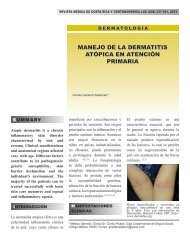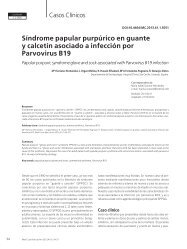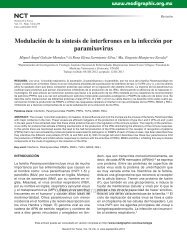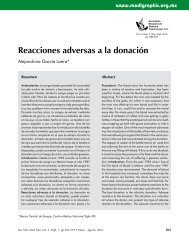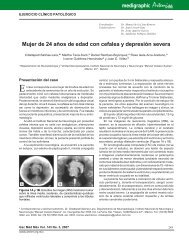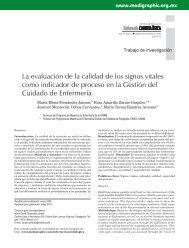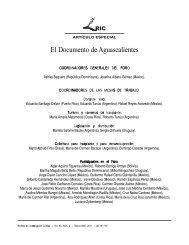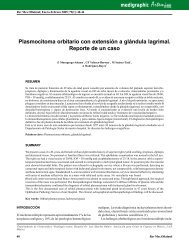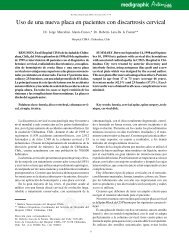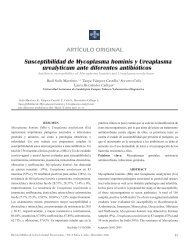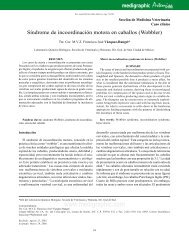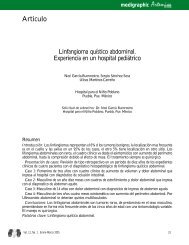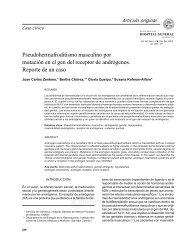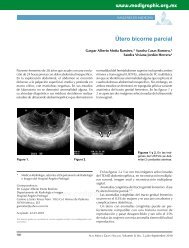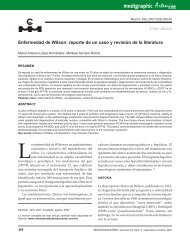Respuesta productiva, fermentación cecal y ... - edigraphic.com
Respuesta productiva, fermentación cecal y ... - edigraphic.com
Respuesta productiva, fermentación cecal y ... - edigraphic.com
Create successful ePaper yourself
Turn your PDF publications into a flip-book with our unique Google optimized e-Paper software.
Abstract<br />
<strong>Respuesta</strong> <strong>productiva</strong>, <strong>fermentación</strong> <strong>cecal</strong> y<br />
morbilidad diarreica en conejos alimentados con<br />
<strong>com</strong>plementos bacterianos de Clostridium sordellii<br />
o Peptostreptococcus tetradius<br />
Productive response, <strong>cecal</strong> fermentation and diarrheic<br />
morbidity in rabbits fed with bacterial supplements of<br />
Clostridium sordellii or Peptostreptococcus tetradius<br />
A bacterial strain of Clostridium sordellii and another one of Peptostreptococcus tetradius (isolated in a previous study, from the<br />
cecum of fattening rabbits) were evaluated as supplements, administered by means of food aspersion on a <strong>com</strong>mercial feed for<br />
weaned fattening white New Zealand rabbits. The study was carried out in a rabbit fattening farm with 60% morbidity and 50%<br />
mortality due to unspecifi c diarrheas. Three experimental groups were formed: the fi rst group was fed normal <strong>com</strong>mercial feed,<br />
the second <strong>com</strong>mercial feed inoculated with C. sordellii and the third, inoculated with P. tetradius. Daily weight gain, feed consumption<br />
and feed effi cacy were evaluated during fi ve weeks, and three tests of apparent digestibility were made. In addition,<br />
the mortality and the morbidity caused by unspecifi c diarrheas during the same period were quantifi ed. After the rabbits were<br />
euthanized, total and cellulolytic bacteria concentration, pH and ammonium concentration were measured from samples taken<br />
from the <strong>cecal</strong> appendix, thirteenth <strong>cecal</strong> loop and colon. The results did not show signifi cant difference (P > 0.05) between the<br />
treatments for any of the production variables measured. Statistical differences (P < 0.05) were found in pH and ammonium concentration<br />
in the <strong>cecal</strong> appendix between the group with C. sordellii and the other two groups, while in the thirteenth <strong>cecal</strong> loop<br />
differences were found (P < 0.05) in ammonium concentration between the group with P. tetradius and the other two groups.<br />
In regard to total bacteria, differences (P < 0.05) were found at the <strong>cecal</strong> appendix level between the control group and the one<br />
that received P. tetradius, and at the colon level between the group that received P. tetradius and the one that received C. sordelli.<br />
C. sordellii supplementation was associated with lower diarrheal morbidity (35%), as <strong>com</strong>pared with that observed in the control<br />
group (80%), and that of the group receiving the P. tetradius supplement (80%) (P < 0.05).<br />
Key words: RABBITS, BACTERIAL SUPPLEMENTS, CECAL MICROFLORA, CECOTROPHS, CLOSTRIDIUM SOR-<br />
DELLII, PEPTOSTREPTOCOCCUS TETRADIUS, PROBIOTICS.<br />
Resumen<br />
www.m<strong>edigraphic</strong>.org.mx<br />
Carlos Gutiérrez Olvera* Mario A. Cobos Peralta** Adriana Ducoing Watty***<br />
David Hernández Sánchez** Raymundo Rodríguez de Lara†<br />
Se evaluó una cepa bacteriana de Clostridium sordellii y otra de Peptostreptococcus tetradius (aisladas en un trabajo previo, a partir<br />
del ciego de conejos en engorda) <strong>com</strong>o <strong>com</strong>plementos, suministrados mediante aspersión en alimento <strong>com</strong>ercial para conejos<br />
Nueva Zelanda, blancos, recién destetados y en etapa de engorda. El trabajo se llevó a cabo en un centro de engorda cunícola<br />
en el cual se presentaba morbilidad de 60% y mortalidad de 50% a causa de diarreas inespecífi cas. Se crearon tres grupos experimentales:<br />
al primero se le proporcionó alimento <strong>com</strong>ercial sin inocular, al segundo se le proporcionó alimento <strong>com</strong>ercial<br />
adicionado con C. sordellii y al tercero, adicionado con P. tetradius. Se evaluó ganancia diaria de peso, consumo de alimento y<br />
efi ciencia alimenticia durante cinco semanas, además se realizaron tres ensayos de digestibilidad aparente. Asimismo, se cuantifi<br />
có la mortalidad y la morbilidad causada por diarreas inespecífi cas durante el periodo señalado. Después del sacrifi cio de los<br />
conejos, se midió la concentración de bacterias totales y celulolíticas, pH y amonio en muestras del apéndice <strong>cecal</strong>, treceava asa<br />
<strong>cecal</strong> y colon. Los resultados no mostraron diferencia signifi cativa (P > 0.05) entre los tratamientos para ninguna de las variables<br />
<strong>productiva</strong>s medidas. Se encontraron diferencias estadísticas (P < 0.05) en el pH y la concentración de amonio a nivel del apén-<br />
Recibido el 6 de septiembre de 2007 y aceptado el 25 de agosto de 2008.<br />
*Departamento de Nutrición Animal y Bioquímica, Facultad de Medicina Veterinaria y Zootecnia, Universidad Nacional Autónoma de<br />
México, 04510, México, D. F.<br />
**Programa de Ganadería, Colegio de Postgraduados, 56230, Montecillo, Texcoco, Estado de México, México.<br />
***Departamento de Genética y Bioestadística, Facultad de Medicina Veterinaria y Zootecnia, Universidad Nacional Autónoma de México,<br />
04510, México, D. F.<br />
†Departamento de Zootecnia, Universidad Autónoma de Chapingo, Km 38.5, carretera México-Texcoco, 56230, Chapingo, Estado de<br />
México, México.<br />
Vet. Méx., 39 (4) 2008<br />
397
Introduction<br />
In 1998, the European Union banned the use<br />
of certain antibiotics in animal feed as growth<br />
promoters, creating the need to look for alternatives<br />
to substitute said products. One alternative<br />
is the use of viable microbial supplements (probiotics),<br />
exogenous enzymes and prebiotics applied in<br />
food. 1,2 Microbial supplements are feed additives that<br />
have a benefi cial effect on the receptor, promoting at<br />
the enteric level an appropriate microbial balance. 3<br />
Experimentally, as well as <strong>com</strong>mercially, different bacteria<br />
have been evaluated (Lactobacillus spp, Bacillus<br />
subtilis and Streptococcus spp), fungi (Aspergillus oryzae)<br />
and yeast (Saccharomyces cerevisiae). 4 Among the benefi<br />
ts produced by microbial supplements the following<br />
should be underlined: enteric disease control, 5,6<br />
immune system stimulation and modulation, 7 control<br />
of certain types of cancer, 8,9 <strong>com</strong>petitive exclusion of<br />
pathogenic microorganisms, 10 recuperation of enteric<br />
microfl ora after antibiotic treatments, 11 as well as an<br />
increase in weight gain, 12 milk production, 13,14 meat<br />
production 15 and feed effi cacy rate. 16,17 Nevertheless,<br />
results are variable and inconsistent, which demonstrates<br />
that there is still much to be researched about<br />
their therapeutic, prophylactic, and growth promotion<br />
potential. 4<br />
In rabbits, microbial cultures have been used to<br />
reduce incidence and death by diarrhea, as well as<br />
increase conversion rate. Studies have been directed<br />
at intestinal pH control using bacteria that are foreign<br />
to rabbit microfl ora. Cheeke et al. 18 evaluated the effect<br />
of Lacto-Sacc © * (Lactobacillus acidophilus, Streptococcus<br />
faecium and Bacillus subtilis) and Acid-Pak 4-Way © *<br />
(Streptococcus faecium and Lactobacillus acidophilus), as<br />
rabbit feed supplements; fi nding that post-weaning<br />
mortality was reduced 50% and 21%, respectively; also,<br />
Acid-Pak 4-Way improved conversion rate. Using the<br />
same products, Hollister et al . 19,20 reduced mortality<br />
by enteritis, 45% and 22% in recently weaned rabbits<br />
with a conversion rate improvement between 13.2%<br />
and 16.9% as <strong>com</strong>pared with the control group. Postweaning<br />
enteric disease mortality reduction has been<br />
related to a <strong>com</strong>petitive inhibition mechanism, which<br />
reduces proliferation of pathogenic microorganisms<br />
such as Clostridium spp and E. coli, besides favoring<br />
398<br />
dice <strong>cecal</strong> entre el grupo al que se le suministró C. sordellii y los dos grupos restantes, mientras que a nivel de la treceava asa <strong>cecal</strong><br />
se encontraron diferencias (P < 0.05) en la concentración de amonio entre el grupo que recibió P. tetradius y los otros dos grupos.<br />
En lo referente a bacterias totales se encontraron diferencias (P < 0.05) a nivel de apéndice <strong>cecal</strong> entre el grupo testigo y el que<br />
recibió P. tetradius, y a nivel de colón distal entre el grupo que recibió C. sordellii y P. tetradius. La administración de C. sordelli<br />
estuvo asociada a una morbilidad diarreica más baja (35%) que la observada en el caso del grupo testigo (80%) y del grupo que<br />
recibió <strong>com</strong>plemento de P. tetradius (80%) (P < 0.05).<br />
Palabras clave: CONEJOS, COMPLEMENTOS BACTERIANOS, MICROFLORA CECAL, CECOTROFOS, CLOSTRI-<br />
DIUM SORDELLII, PEPTOSTREPTOCOCCUS TETRADIUS, PROBIÓTICOS.<br />
Introducción<br />
En 1998 la Unión Europea prohibió el uso de<br />
algunos antibióticos en la alimentación animal<br />
<strong>com</strong>o promotores del crecimiento, creando la<br />
necesidad de buscar alternativas para sustituir esos<br />
productos. Una es la utilización de <strong>com</strong>plementos<br />
microbianos viables (probióticos), enzimas exógenas<br />
y prebióticos que se aplican en el alimento. 1,2 Los<br />
<strong>com</strong>plementos microbianos son aditivos alimenticios<br />
que afectan benéfi camente al portador, promoviendo<br />
a nivel entérico un balance microbiano adecuado. 3<br />
Tanto experimental <strong>com</strong>o <strong>com</strong>ercialmente se han evaluado<br />
diferentes bacterias (Lactobacillus spp, Bacillus<br />
subtilis y Streptococcus spp), hongos (Aspergillus oryzae)<br />
y levaduras (Saccharomyces cerevisiae). 4 Entre los benefi<br />
cios producidos por los <strong>com</strong>plementos microbianos<br />
destaca el control de enfermedades entéricas, 5,6<br />
la estimulación y modulación del sistema inmune, 7<br />
el control de algunos tipos de cáncer, 8,9 la exclusión<br />
<strong>com</strong>petitiva de microorganismos patógenos, 10 la recuperación<br />
de la microfl ora entérica después del tratamiento<br />
con antibióticos, 11 así <strong>com</strong>o el incremento en<br />
ganancia de peso, 12 producción láctea, 13,14 producción<br />
de carne 15 y efi ciencia alimenticia. 16,17 Sin embargo,<br />
los resultados son variables e inconsistentes, lo cual<br />
muestra que todavía es necesario investigar su potencial<br />
profi láctico, terapéutico y <strong>com</strong>o promotores del<br />
crecimiento. 4<br />
En conejos, los cultivos microbianos se han utilizado<br />
para reducir la incidencia y muerte por diarreas,<br />
así <strong>com</strong>o para incrementar la efi ciencia <strong>productiva</strong>.<br />
Los estudios se han encaminado hacia el control del<br />
pH intestinal utilizando bacterias ajenas a la microfl<br />
ora del conejo. Cheeke et al. 18 evaluaron el efecto<br />
del Lacto-Sacc MR * (Lactobacillus acidophilus, Streptococcus<br />
faecium y Bacillus subtilis) y Acid-Pak 4-Way MR *<br />
(Streptococcus faecium y Lactobacillus acidophilus), <strong>com</strong>o<br />
<strong>com</strong>plementos en la alimentación de conejos; la mortalidad<br />
posdestete se redujo 50% y 21%, respectivamente;<br />
además, Acid-Pak 4-Way mejoró la efi ciencia<br />
alimenticia. Usando los mismos productos, Hollister<br />
et al. 19,20 redujeron 45% y 22% la mortalidad por ente-<br />
*Lacto-Sacc® y Acid-Pak 4-Way®, Alltech Inc., Estados<br />
Unidos de América.
non-pathogenic enteric microorganisms’ growth.<br />
A mix of Lactobacillus bulgaricus and Streptococcus<br />
thermophilus or Streptococcus faecium, improved health,<br />
even though there was no effect on growth or feeding<br />
of the rabbits under study. 21<br />
In a previous study two bacteria were isolated:<br />
Clostridium sordellii and Peptostreptococcus tetradius from<br />
cecotrophs obtained from New Zealand breed rabbits.<br />
22 In another study it was determined that inoculation<br />
of these bacteria into <strong>com</strong>pressed rabbit feed<br />
does not produce noxious effects or feed rejection<br />
from recently weaned rabbits. Likewise, cellulolytic<br />
bacteria concentration increased in <strong>cecal</strong> appendix<br />
and in in vitro digestion of dry matter; 23 nevertheless,<br />
the effect on the incidence of infectious diseases was<br />
not evaluated.<br />
Experimentally, secondary metabolites produced<br />
by bacteria have been evaluated. For example, the<br />
addition of toyocerin (produced by Bacillus toyoi) in<br />
rabbit feed reduced the incidence of colitis and enteric<br />
infections. 24<br />
Enteric diseases represent a relevant problem in<br />
rabbit production. Losses due to enteritis normally<br />
reach between 10% to 20% of the total amount of animals;<br />
although there are times when enteric processes<br />
may cause losses of up to 20%-60% of weaned animals.<br />
What causes these diseases is not known <strong>com</strong>pletely<br />
and prevention and treatment measures are<br />
not always effective. 25<br />
Rabbit enteritis may be caused by several microorganisms<br />
and some predisposing factors. Among the<br />
main microorganisms that cause enteric diseases in<br />
rabbits are Clostridium spiriforme, Escherichia coli, rotavirus<br />
and coccidia. Factors that may predispose animals<br />
to enteric diseases are: feed (diets with low levels of<br />
fi ber, high levels of carbohydrates), stress, antibiotics<br />
and genetics. 25<br />
The rabbit farm where the animals for this study<br />
were lodged had a non-specifi c enteritis problem with<br />
60% morbidity and mortality close to 50% in the fi rst<br />
weeks after weaning. Sick animals had an abundant,<br />
mucoid diarrhea, anorexia, ataxia, dehydration and<br />
death happened between one to two days after showing<br />
symptoms. At necropsy, animals showed <strong>cecal</strong><br />
infl ammation and a large amount of accumulated gas<br />
in the whole large intestine, without apparent lesions<br />
in other organs.<br />
In order to look for alternatives to the use of growth<br />
promoters that are now illegal, and reduce prevalence<br />
of diarrheas in rabbits, improving their productive<br />
parameters, the objective of this study was the evaluation<br />
of the effect of Clostridium sordelli and Peptostreptococcus<br />
tetradius, administered as dietetic supplements.<br />
ritis en conejos recién destetados y mejoraron entre<br />
13.2% y 16.9% la efi ciencia alimenticia con respecto<br />
al tratamiento testigo. La disminución en mortalidad<br />
posdestete, por enfermedades entéricas, se ha relacionado<br />
con un mecanismo de inhibición <strong>com</strong>petitiva,<br />
que reduce la proliferación de patógenos, <strong>com</strong>o Clostridium<br />
spp y E. coli, además de que favorece el crecimiento<br />
de microorganismos entéricos no patógenos.<br />
La utilización de una mezcla de Lactobacillus bulgaricus<br />
y Streptococcus thermophilus o Streptococcus faecium,<br />
mejoró la salud, aunque sin efecto en el crecimiento y<br />
alimentación de los conejos en estudio. 21<br />
En un trabajo previo se aislaron dos bacterias:<br />
Clostridium sordellii y Peptostreptococcus tetradius a partir<br />
de cecotrofos obtenidos de conejos de la raza Nueva<br />
Zelanda. 22 En otro estudio se determinó que la inoculación<br />
de estas bacterias en alimento <strong>com</strong>primido<br />
para conejo no produce efectos nocivos o rechazo en<br />
consumo de alimento en conejos recién destetados.<br />
Además se encontró aumento en la concentración de<br />
bacterias celulolíticas en apéndice <strong>cecal</strong> y en la digestión<br />
in vitro de la materia seca. 23 Sin embargo, no se<br />
evaluó su efecto en la incidencia de enfermedades<br />
infecciosas.<br />
Experimentalmente, se ha evaluado el uso de<br />
metabolitos secundarios producidos por bacterias.<br />
Por ejemplo, la adición de toyocerina (producida por<br />
Bacillus toyoi) al alimento de conejos, disminuyó la<br />
incidencia de colitis e infecciones entéricas. 24<br />
Las enfermedades entéricas representan un problema<br />
relevante en la producción de conejos. Las pérdidas<br />
por enteritis son normalmente de 10% a 20%<br />
del total de animales; aunque se llegan a presentar<br />
procesos entéricos (enteropatías) que provocan pérdidas<br />
de 20%-60% de los animales destetados. La causa<br />
de estas enfermedades no se conoce perfectamente y<br />
las medidas de prevención y tratamiento no son siempre<br />
efectivas. 25<br />
La enteritis en los conejos puede ser causada por<br />
diversos microorganismos y algunos factores predisponentes.<br />
Entre los principales microorganismos<br />
causantes de enfermedades entéricas en conejos se<br />
encuentran Clostridium spiriforme, Escherichia coli, rotavirus<br />
y coccidias. Los factores que pueden predisponer<br />
a enfermedades entéricas son: alimenticios (bajos<br />
niveles de fi bra, altos niveles de carbohidratos en la<br />
dieta), estrés, antibióticos y genéticos. 25<br />
En el centro cunícola donde fueron alojados los<br />
animales utilizados en este estudio, se tenía el problema<br />
de enteritis inespecífi ca con morbilidad de<br />
60% y mortalidad cercana a 50% en las primeras<br />
semanas posdestete. Los animales enfermos presentaban<br />
diarrea mucoide profusa, anorexia, ataxia, deshidratación<br />
y muerte entre uno y dos días después de<br />
presentados los signos clínicos. A la necropsia, los ani-<br />
Vet. Méx., 39 (4) 2008<br />
399
Material and methods<br />
This study was carried out in the Ruminal Microbiology<br />
and Animal Nutrition laboratories of the Postgraduate<br />
College Livestock Program (IREGEP) and<br />
in the Rabbit Research Center (COCICEMAC), in<br />
Montecillo and Coatlinchan, respectively, Texcoco,<br />
State of Mexico, Mexico.<br />
Sixty New Zealand white recently weaned, 38 days<br />
old male rabbits were used. Animals did not receive<br />
any treatment (antibiotics or anti-parasitic drugs)<br />
before participating in the experiment, in order to<br />
allow the infectious process to be expressed.<br />
Rabbits were lodged in galvanized steel mesh cages<br />
measuring 60 cm in width, 90 cm in length and 40 cm<br />
in height. Each cage had an automatic drinker and<br />
two galvanized steel feeders with a capacity for 2 kg of<br />
<strong>com</strong>pressed feed.<br />
Under each cage, a polyester mesh was placed, in<br />
order to retain animal excrement for later weighing.<br />
Each day animals were inspected and cleaning was<br />
carried out.<br />
Three experimental groups of 20 rabbits each were<br />
formed. Four animals were placed in each cage per<br />
experimental unit, so that each treatment had fi ve<br />
repetitions.<br />
Animals were identifi ed with indelible ink marks<br />
and distributed randomly in the cages, and then they<br />
were subjected to the different experimental treatments.<br />
Animals had water and food available ad libitum.<br />
Used <strong>com</strong>mercial feed was “Conejitina 715”,* that contains<br />
88.72% DM, 16.49% CP, 23.95% ADF, 42.45%<br />
NDF and 10.01% ash.<br />
The three evaluated treatments consisted of feeding<br />
weaned rabbits with <strong>com</strong>pressed <strong>com</strong>mercial feed<br />
specifi c for the fattening phase, as control group (T1);<br />
with <strong>com</strong>pressed <strong>com</strong>mercial feed previously inoculated<br />
by aspersion with Clostridium sordellii at a concentration<br />
of 1× 10 8 bacteria per g –1 of feed (T2) and<br />
<strong>com</strong>pressed <strong>com</strong>mercial feed previously inoculated by<br />
aspersion with Peptostreptococcus tetradius, at a concentration<br />
of 1 × 10 8 bacteria per g –1 of feed (T3).<br />
Responses of the following variables were measured:<br />
Feed consumption. Offered and rejected feed per<br />
cage was weighed each week and difference was estimated.<br />
Data obtained were divided by number of animals<br />
per cage to establish average feed consumption<br />
per animal.<br />
Daily weight gain. Each animal was weighed two<br />
consecutive times and data was divided by the number<br />
of days between each weighing (seven days). Rabbits<br />
were weighed in the morning before feeding at the<br />
400<br />
males presentaban infl amación <strong>cecal</strong> y gran cantidad<br />
de gas acumulado en todo el intestino grueso, sin presencia<br />
de daños aparentes a otros órganos.<br />
Con el proposito de buscar alternativas al uso de<br />
promotores del crecimiento ilegales, para disminuir<br />
la prevalencia de diarrea en conejos y mejorar sus<br />
parámetros productivos, el objetivo de este trabajo<br />
fue evaluar el efecto de Clostridium sordelli y Peptostreptococcus<br />
tetradius, administrados <strong>com</strong>o <strong>com</strong>plementos<br />
dietéticos.<br />
Material y métodos<br />
Este trabajo se llevó a cabo en los laboratorios de<br />
Microbiología Ruminal y Nutrición Animal, del Programa<br />
de Ganadería (IREGEP) del Colegio de Postgraduados,<br />
y en el Centro de Investigación Cunícola<br />
(COCICEMAC), en Montecillo y Coatlinchán, respectivamente,<br />
en Texcoco, Estado de México, México.<br />
Se utilizaron 60 conejos machos de la raza Nueva<br />
Zelanda blanco, recién destetados, de 38 días de edad.<br />
Los animales no recibieron ningún tratamiento (desparasitantes,<br />
antibióticos) antes de entrar al trabajo<br />
experimental, con la fi naldad de que se expresara<br />
cualquier proceso infeccioso.<br />
Los conejos fueron alojados en jaulas de alambre<br />
galvanizado de 60 cm de ancho, 90 cm de largo y 40<br />
cm de alto. Cada jaula contó con un bebedero automático<br />
y dos <strong>com</strong>ederos de lámina galvanizada, con<br />
capacidad para 2 kg de alimento <strong>com</strong>primido.<br />
Bajo cada jaula se colocó una malla de poliéster,<br />
con el fi n de detener el excremento de los animales<br />
para su posterior pesaje. Cada día se llevó a cabo la<br />
limpieza e inspección de los animales.<br />
Se conformaron tres grupos experimentales de 20<br />
conejos cada uno. Se alojaron cuatro animales por<br />
jaula (unidad experimental), por lo que cada tratamiento<br />
contó con cinco repeticiones.<br />
Los animales fueron identifi cados mediante marcaje<br />
con tinta indeleble y distribuidos aleatoriamente<br />
en las jaulas, y éstas, a su vez, a los diferentes tratamientos<br />
experimentales.<br />
A los animales se les proporcionó agua y alimento<br />
ad libitum. Como alimento se utilizó “Conejitina 715”,*<br />
que contiene 88.72% de MS, 16.49% de PC, 23.95%<br />
de FDA, 42.45% de FDN y 10.01% de cenizas.<br />
Los tratamientos evaluados consistieron en alimentar<br />
a los conejos destetados con alimento <strong>com</strong>ercial<br />
<strong>com</strong>primido para fase de engorda (T1), este grupo se<br />
consideró <strong>com</strong>o testigo; alimento <strong>com</strong>ercial <strong>com</strong>primido<br />
previamente inoculado por aspersión con Clostridium<br />
sordellii a concentración de 1 × 10 8 bacterias g –1<br />
de alimento (T2) y alimento <strong>com</strong>ercial <strong>com</strong>primido<br />
previamente inoculado por aspersión con Peptostrepto-<br />
*Hacienda, México.
eginning of the experiment and after that once every<br />
week.<br />
Conversion rate. It was estimated by dividing weight<br />
gain by total consumed feed.<br />
Carcass yield. Recently processed carcass (without<br />
head, viscera, skin and legs) was weighed and relationship<br />
with total weight before sacrifi ce was estimated.<br />
Feces production. During the experimental study,<br />
feces from the animals were collected and weighed<br />
daily. Every week a sample was taken from feces and<br />
from offered feed (20 g to 30 g) to quantify dry matter<br />
content (DM).<br />
Apparent digestibility. Apparent digestibility at fi fth<br />
week of the experiment was quantifi ed for dry matter<br />
(DM) organic matter (OM), crude protein (CP), neutral<br />
detergent fi ber (NDF) and acid detergent fi ber<br />
(ADF). Quantifi cation of DM, OM, and CP in feces<br />
and feed was carried out according to methodology<br />
described by AOAC; and for NDF and ADF, Van Soest<br />
et al. 26 methodology was used.<br />
Animals were observed daily to record deaths,<br />
and verify health status of the animals checking for<br />
the presence of diarrhea, vomit, depression, sneezing,<br />
tearing, coughing, etc.<br />
Five weeks after the beginning of the fattening<br />
period, four rabbits were euthanized per each treatment<br />
(a total of 12 rabbits randomly chosen). Each<br />
rabbit’s digestive tract was extracted in order to aseptically<br />
collect samples from cecum appendix, third<br />
<strong>cecal</strong> loop and colon (distal portion). Samples were<br />
deposited in sterile jars.<br />
Each sample was tested for the following:<br />
Total bacteria. Most probable number technique<br />
was used (MPN). 27 Serial dilutions were carried out<br />
from 10 –1 to 10 –14 of each sample from cecum appendix,<br />
third <strong>cecal</strong> loop and distal colon from each one<br />
of the 12 euthanized animals. Dilutions were carried<br />
out in 13 × 100 mm culture tubes with 4.5 mL culture<br />
medium for anaerobe bacteria (Table 1).<br />
Cellulolytic bacteria. MPN technique was also used.<br />
Serial dilutions were carried out from 10 -1 to 10 -10 in 13<br />
× 100 mm culture tubes with 4.5 mL culture medium<br />
for anaerobe bacteria similar to the one used for<br />
total bacteria, adding a Whatman number 541 paper<br />
strip (0.5 × 1.5 cm), instead of glucose, cellobiose and<br />
starch. 28<br />
Ammonium. Two grams of sample were taken and<br />
mixed with 0.5 mL meta-phosphoric acid, in 2 mL<br />
vials to determine ammonium nitrogen. The samples<br />
were centrifuged* at 16 500 g for three minutes and<br />
supernatant was deposited in 2.5 mL vials for analysis<br />
by visible ultraviolet spectrometer absorbency.**<br />
pH. In order to measure pH, a gram of sample was<br />
taken and diluted in 9 mL of distilled water, homogenized<br />
and allowed to rest for 15 to 30 min, to then<br />
coccus tetradius, a concentración de 1 × 10 8 bacterias g –1<br />
de alimento (T3).<br />
Se midieron <strong>com</strong>o respuesta, las siguientes variables:<br />
Consumo de alimento. Se pesó semanalmente el alimento<br />
ofrecido y el rechazado por jaula y se calculó la<br />
diferencia entre ambos. Los datos se dividieron entre<br />
el número de animales alojados en cada jaula, calculándose<br />
así el consumo promedio de alimento por<br />
animal.<br />
Ganancia diaria de peso. Se calculó mediante la<br />
diferencia obtenida de dos mediciones de peso consecutivas<br />
de cada animal y la división de ésta entre el<br />
número de días transcurridos entre cada pesaje (siete<br />
días). Los conejos se pesaron al principio del trabajo<br />
experimental y después semanalmente; el pesaje se<br />
llevó a cabo por la mañana antes de proporcionar el<br />
alimento.<br />
Efi ciencia alimenticia. Se calculó a partir de la<br />
ganancia de peso, dividida entre el alimento total consumido<br />
por cada animal.<br />
Rendimiento de la canal. Se calculó con base en el<br />
peso de la canal caliente (sin cabeza, vísceras, piel<br />
y extremidades), y en relación con el peso total del<br />
animal antes del sacrifi cio.<br />
Producción de heces. Durante el trabajo experimental<br />
se recolectaron las heces de los animales y se pesaron<br />
diariamente. Semanalmente se tomó una muestra<br />
de heces y del alimento ofrecido (20 g a 30 g) para<br />
determinar su contenido de materia seca (MS).<br />
Digestibilidad aparente. Se evaluó la digestibilidad<br />
aparente de la MS, materia orgánica (MO), proteína<br />
cruda (PC), fi bra detergente neutra (FDN) y fi bra<br />
detergente ácida (FDA) a la quinta semana de <strong>com</strong>enzado<br />
el trabajo experimental. La determinación de<br />
MS, MO y PC en heces y alimento, se hizo mediante<br />
la metodología descrita por la AOAC y la FDN y FDA,<br />
siguiendo la metodología de Van Soest et al. 26<br />
Se verifi có diariamente el estado de salud de los<br />
animales (presencia de diarreas, vómitos, depresión,<br />
estornudos, lagrimeo, tos, etc.) y se registraron las<br />
muertes.<br />
Se sacrifi caron cuatro conejos de cada tratamiento<br />
(12 conejos en total, elegidos aleatoriamente) cinco<br />
semanas depués de que inició el periodo de engorda.<br />
A cada conejo se le extrajo el tubo digestivo con el propósito<br />
de recolectar, de forma aséptica, muestras del<br />
apéndice <strong>cecal</strong>, ciego (tercer asa <strong>cecal</strong>) y colon (sección<br />
distal). Las muestras se depositaron en frascos<br />
estériles. A cada muestra se le determinó:<br />
Bacterias totales. Se utilizó la técnica del número<br />
más probable (NMP). 27 Se realizó una serie de diluciones<br />
de 10 –1 hasta 10 –14 para cada muestra recolectada<br />
de apéndice <strong>cecal</strong>, tercer asa <strong>cecal</strong> y colon distal<br />
de cada uno de los 12 animales sacrifi cados. Las dilu-<br />
Vet. Méx., 39 (4) 2008<br />
401
obtain the pH reading by potentiometer*** calibrated<br />
to pH 4 and 7.<br />
Data was analyzed by totally random design of the<br />
three treatments (diets) with fi ve repetitions per treatment<br />
(cages with four animals each) according to the<br />
following model:<br />
where:<br />
402<br />
Yij= µ + Ti + εij<br />
Yij = apparent digestibility of DM, OM, CP, NDF, ADF<br />
of animals of jth cage of treatment ith.<br />
j = 1,...5<br />
i = 1,...3<br />
µ = general mean<br />
Ti = effect of treatment i-th<br />
εij = experimental error of jth cage of treatment i-th.<br />
Initial live weight was used as co-variable for daily<br />
weight gain, feed consumption, conversion rate, and<br />
carcass yield.<br />
where:<br />
Yij= µ + Ti + ß (Xij – X) + εij<br />
Yij = daily weight gain, feed effi cacy, carcass yield of of<br />
animals of jth cage of treatment i-th.<br />
j = 1,...5<br />
i = 1,...3<br />
µ = general mean<br />
Ti = effect of treatment i-th<br />
ß = effect of initial weight<br />
εij = experimental error of j-th cage of treatment i-th.<br />
Information analysis was carried out by the SAS statistical<br />
software, 29 using GLM procedure. For multiple<br />
<strong>com</strong>parisons Tukey’s test was used.<br />
In cases where expected homogeneity of variance<br />
and normality did not happen, the non-parametric<br />
Kruskall-Wallis test was carried out. 30<br />
Methodology proposed by Harrigan and McCance 26<br />
was used to quantify the number of total and cellulolytic<br />
bacteria.<br />
Results<br />
T2 animals (C. sordellii) had 35% non-specifi c diarrheas<br />
morbidity that was statistically lower (P < 0.05)<br />
than morbidity found in the other two groups (80%).<br />
Mortality in T2 was 25%, lower than in the other two<br />
groups (45% for T1 and 75% for T2) with 0.067 signifi -<br />
cance (Table 2).<br />
In general there were no statistically signifi cant differences<br />
between treatments (P < 0.05) in relation to<br />
productive variables (weight gain, feed consumption,<br />
conversion rate and carcass yield) (Tables 3, 4 and 5).<br />
ciones se realizaron en tubos de cultivo de 13 × 100<br />
mm, con 4.5 mL de medio de cultivo para bacterias<br />
anaerobias (Cuadro 1).<br />
Bacterias celulolíticas. Se utilizó también la técnica<br />
del NMP. Se realizaron diluciones de 10 –1 hasta 10 –10 ,<br />
en tubos para cultivo de 13 × 100 mm con 4.5 mL de<br />
un medio de cultivo similar al utilizado para bacterias<br />
totales, en el cual se adicionó una tira de papel (0.5 ×<br />
1.5 cm) Whatman número 541, en lugar de glucosa,<br />
celobiosa y almidón. 28<br />
Amonio. Para determinar nitrógeno amoniacal se<br />
tomaron 2 g de cada muestra y se mezclaron con 0.5<br />
mL de ácido metafosfórico, en viales de 2 mL. Posteriormente<br />
las muestras se centrifugaron* a 16 500<br />
g durante tres minutos y se depositó el sobrenadante<br />
en viales de 2.5 mL para luego analizarlo mediante<br />
absorbancia en un espectrómetro de luz ultravioleta<br />
visible.**<br />
pH. Con el propósito de medir el pH se tomó un<br />
gramo de muestra, se diluyó en 9 mL de agua destilada,<br />
se homogeneizó y se dejó reposar durante 15 a<br />
30 min, para después obtener la lectura del pH en un<br />
potenciómetro*** calibrado a pH 4 y 7.<br />
El análisis de los datos corresponde al de un<br />
diseño <strong>com</strong>pletamente al azar con tres tratamientos<br />
(dietas) y cinco repeticiones por tratamiento (jaulas<br />
con cuatro animales cada una). El modelo que corresponde<br />
a dicho diseño es:<br />
donde:<br />
Yij= µ + Ti + εij<br />
Yij = digestibilidad aparente de MS, MO, PC, FDN,<br />
FDA de los animales de la jaula j del tratamiento i.<br />
j = 1,...5<br />
i = 1,...3<br />
µ = media general<br />
Ti = efecto del tratamiento i<br />
εij = error experimental de la jaula j del tratamiento i.<br />
Para el caso de ganancia diaria de peso, consumo<br />
de alimento, efi ciencia alimenticia y rendimiento de<br />
canal, se utilizó el peso vivo inicial <strong>com</strong>o covariable.<br />
Yij= µ + Ti + ß (Xij – Χ) + εij<br />
donde:<br />
Yi = ganancia diaria de peso, efi ciencia alimenticia,<br />
rendimiento de la canal de los animales de la jaula j<br />
del tratamiento i.<br />
j = 1,...5<br />
i = 1,...3<br />
µ = media general<br />
*Centrifuga Eppendorf Centrifuge 5804, Alemania.<br />
**Perkin Elmer Lambda 40, Estados Unidos de América.<br />
***Orion, Modelo 250ª, Estados Unidos de América.
Apparent digestibility assay carried out in the fi fth<br />
week of study, did not show signifi cant statistical differences<br />
between treatments (Table 6).<br />
In relation to total bacteria, differences were found<br />
(P < 0.05) at the level of <strong>cecal</strong> appendix between the<br />
control group and the group that received P. tetradius<br />
and at the level of the distal colon between the groups<br />
that received C. sordellii and P. tetradius (Table 7).<br />
In the <strong>cecal</strong> appendix, for pH (Table 8) as well as<br />
for ammonium (Table 9) there was signifi cant statistical<br />
difference between T2 (C. sordellii) and the<br />
other two treatments, while at the level of the thirteenth<br />
<strong>cecal</strong> loop, differences were found (P < 0.05)<br />
in ammonium concentration between the group that<br />
received P. tetradius and the other two groups.<br />
Discussion<br />
As mentioned by Mateos, 31 the basic idea behind the<br />
addition of bacterial supplements to rabbit diets is to<br />
avoid, by a <strong>com</strong>petition mechanism the proliferation<br />
of germs that are harmful in the animal intestines.<br />
Cheeke et al. 32 reports that in several studies bacterial<br />
Ti = efecto del tratamiento i<br />
ß = efecto del peso inicial<br />
εij = error experimental de la jaula j del tratamiento i.<br />
El análisis de la información se realizó mediante<br />
el paquete estadístico SAS, 29 utilizándo el procedimiento<br />
GLM. Para <strong>com</strong>paraciones múltiples se usó la<br />
prueba de Tukey.<br />
En los casos en los que los supuestos de homogeneidad<br />
de varianza y normalidad no se cumplieron,<br />
se realizó la prueba no paramétrica de Kruskall-<br />
Wallis. 30<br />
Para medir el número de bacterias celulolíticas y<br />
totales se utilizó la metodología propuesta por Harrigan<br />
y McCance. 26<br />
Resultados<br />
Los animales del T2 (C. sordellii) presentaron morbilidad<br />
de 35% por diarreas inespecífi cas, que fue<br />
estadísticamente menor (P < 0.05) que la morbilidad<br />
encontrada en los otros dos grupos (80%). La mortalidad<br />
en T2 fue de 25%, menor que la de los otros<br />
dos grupos (45% para T1 y 75% para T2) con signifi -<br />
cancia de 0.067 (Cuadro 2).<br />
Cuadro 1<br />
COMPOSICIÓN DEL MEDIO ANAEROBIO PARA BACTERIAS TOTALES<br />
(POR CADA 100 mL DE MEDIO)<br />
COMPOSITION OF ANAEROBE MEDIUM FOR TOTAL BACTERIA<br />
(PER100 mL OF MEDIUM)<br />
Yeast extract, g 0.1<br />
Trypticase - Peptone, g 0.2<br />
Glucose, mg 60.0<br />
Cellobiose, mg 60.0<br />
Starch, mg 60<br />
Mineral solution 1 a , mL 5.0<br />
Mineral solution 2 b , mL 5.0<br />
Clarified ruminal liquid c , mL 30.0<br />
Sulfide cysteine solution d , mL 2.0<br />
Sodium carbonate 8% solution, mL 5.0<br />
Distilled water, mL 52.6<br />
Rezarsurin solution, mL 0.1<br />
a<br />
Per each liter: K2HPO4, 6.0 g.<br />
b<br />
Per each liter: KH2PO4, 6.0 g; (NH4)2 SO4 , 6.0 g; NaCl, 12 g; MgSO4, 2.45 g; CaCl-2H2O, 1.6 g,<br />
c<br />
Previously filtered through gauze and centrifuged at 23,000 g for 20 min, at 8°C and sterilized at 15 psi<br />
for 15 min.<br />
d<br />
2.5 g of L- cysteine -HCl.H2O were dissolve in 50 mL in distilled H2O, adjusting pH of the mix to 10 with<br />
NaOH (2N); 2.5 g of Na2S-9H2O were added and sufficient amount of distilled H2O was added for 200<br />
mL; the solution was kept 5 min under N2 flow.<br />
Vet. Méx., 39 (4) 2008<br />
403
supplements have reduced the incidence of enteric<br />
infections and animal mortality.<br />
Animals fed with C. sordellii showed more resistance<br />
to enteric infections, since morbidity (P < 0.05)<br />
and mortality (P < 0.07) were lower than in the other<br />
two treatments. Reduction of morbidity and mortality<br />
may be due to <strong>com</strong>petitive inhibition, in the digestive<br />
tract by C. sordellii of pathogenic bacteria that occupy<br />
the same ecological niches. An advantage of C. sordellii<br />
over P. tetradius is that since it is a bacterium that<br />
sporulates, it has a higher probability of reaching the<br />
large intestine and colonize it in a similar manner<br />
as what has been reported for Bacillus toyoi, 24 supplements<br />
that have shown capability to colonize the large<br />
intestine of rabbits and act as <strong>com</strong>petitive inhibitors<br />
that exclude pathogenic microorganisms such as E.<br />
coli and several species of clostridia, that cause postweaning<br />
diarrhea.<br />
According to the results, P. tetradius does not have<br />
an important effect on the prevention or protection<br />
against enteric diseases. Perhaps doses of these bacteria<br />
that were used were not capable of <strong>com</strong>peting<br />
against other microorganisms.<br />
In relation to productive variables, the only one to<br />
show statistically signifi cant differences between treatments<br />
was weight gain in the second week (Table 3)<br />
and this was due to the loss of weight of group three<br />
(P. tetradius), since the animals were extremely affected<br />
by enteritis; which in turn directly affected feed consumption<br />
reducing it signifi cantly in this treatment<br />
during the third week (Table 4). Even though from<br />
the third week conversion rate increased in T3 (P <<br />
0.05), in relation to the other two treatments (prob-<br />
404<br />
En general no se encontraron diferencias estadísticamente<br />
signifi cativas entre los tratamientos (P<br />
> 0.05) para las variables <strong>productiva</strong>s (ganancia de<br />
peso, consumo de alimento, efi ciencia alimenticia y<br />
rendimiento de la canal) (Cuadros 3, 4 y 5).<br />
El ensayo de digestibilidad aparente que se llevó a<br />
cabo a la quinta semana de iniciado el trabajo experimental,<br />
no mostró diferencias estadísticas signifi cativas<br />
entre los tratamientos (Cuadro 6).<br />
En lo referente a bacterias totales se encontraron<br />
diferencias (P < 0.05) a nivel de apéndice <strong>cecal</strong> entre<br />
el grupo testigo y el que recibió P. tetradius y a nivel de<br />
colón distal entre el grupo que recibió C. sordellii y P.<br />
tetradius (Cuadro 7).<br />
En el apéndice <strong>cecal</strong>, tanto para pH (Cuadro 8)<br />
<strong>com</strong>o para amonio (Cuadro 9) sí hubo diferencia<br />
estadística signifi cativa entre el T2 (C. sordellii) y los<br />
otros dos tratamientos, mientras que a nivel de la 13<br />
asa <strong>cecal</strong> se encontraron diferencias (P < 0.05) en la<br />
concentración de amonio entre el grupo que recibió<br />
P. tetradius y los otros dos grupos.<br />
Discusión<br />
Como menciona Mateos, 31 la idea básica de la adición<br />
de <strong>com</strong>plementos bacterianos a la dieta de los conejos<br />
es evitar, mediante un mecanismo de <strong>com</strong>petición, la<br />
proliferación de gérmenes perjudiciales en el intestino<br />
del animal. Cheeke et al. 32 <strong>com</strong>entan que varios<br />
estudios con <strong>com</strong>plementos bacterianos han reducido<br />
la incidencia de infecciones entéricas y la mortalidad<br />
de los animales.<br />
Los animales alimentados con C. sordellii mostraron<br />
Cuadro 2<br />
PORCENTAJE DE MORTALIDAD Y MORBILIDAD DIARREICA DURANTE EL PERIODO<br />
EXPERIMENTAL DE CONEJOS ALIMENTADOS CON DIETA COMERCIAL,<br />
SOLA O ADICIONADA CON COMPLEMENTOS BACTERIANOS<br />
DIARRHEAL MORTALITY AND MORBIDITY PERCENTAGE OF RABBITS FED<br />
COMMERCIAL DIET, ALONE OR WITH ADDED BACTERIAL SUPPLEMENTS<br />
T1<br />
x<br />
Mortality 45 a 25 a 75 a 13.23<br />
Diarrheal<br />
80<br />
Morbidity<br />
a 35 b 80 a 8.42<br />
T1 = Commercial feed without inoculation.<br />
T2 = T1 added with Clostridium sordellii.<br />
T3 = T1 added with Peptostreptococcus tetradius<br />
a,b = Means with different letter in a row, show statistically significant differences (P< 0.05).<br />
ee = Mean standard error<br />
T2<br />
x<br />
T3<br />
x<br />
ee
Cuadro 3<br />
PESO INICIAL, FINAL Y GANANCIA DIARIA DE PESO (g) POR SEMANA,<br />
DE CONEJOS ALIMENTADOS CON UNA DIETA COMERCIAL, SOLA O<br />
ADICIONADA CON COMPLEMENTOS BACTERIANOS<br />
INITIAL AND FINAL WEIGHT AND DAILY WEIGHT GAIN (g) PER WEEK OF RABBITS<br />
FED COMMERCIAL DIET, ALONE OR WITH ADDED BACTERIAL SUPPLEMENTS<br />
T1<br />
x ± ee<br />
T2<br />
x ± ee<br />
T3<br />
x ± ee<br />
Initial weight 833 ± 14.75ª 805 ± 14.75ª 783.75 ± 14.75ª<br />
Final weight 1887.8 ± 74.86ª 1910.0 ± 66.95ª 1966.9 ± 74.86ª<br />
daily weight gain (g) per week<br />
Week 1 28.8 ± 4.04 a 32.1 ± 3.62 a 39.8 ± 4.04 a<br />
Week 2 27.7 ± 8.36 a 30.1 ± 7.48 a -6.6 ± 8.36 b<br />
Week 3 25.6 ± 5.63 a 35.6 ± 5.03 a 46.7 ± 5.63 a<br />
Week 4 38.7 ± 3.95 a 31.8 ± 3.53 a 46.7 ± 3.95 a<br />
Week 5 24.1 ± 6.81 a 25.2 ± 6.09 a 46.3 ± 6.81 a<br />
Average 29.2 ± 1.97 a 30.9 ± 1.76 a 34.7 ± 1.97 a<br />
T1 = Commercial feed without inoculation.<br />
T2 = T1 added with Clostridium sordellii.<br />
T3 = T1 added with Peptostreptococcus tetradius<br />
a,b = Means with different letter in a row, show statistically significant differences (P < 0.05).<br />
ee = Mean standard error<br />
Cuadro 4<br />
CONSUMO DE ALIMENTO DIARIO (g) EN CONEJOS ALIMENTADOS CON UNA DIETA<br />
COMERCIAL SOLA O ADICIONADA CON COMPLEMENTOS BACTERIANOS<br />
DAILY FEED CONSUMPTION (g) IN RABBITS FED COMMERCIAL DIET,<br />
ALONE OR WITH ADDED BACTERIAL SUPPLEMENTS<br />
T1<br />
x ± ee<br />
T2<br />
x ± ee<br />
T3<br />
x ± ee<br />
Week 1 73.2 ± 5.9ª 73.3 ± 5.28ª 73.0 ± 5.9ª<br />
Week 2 67.4 ± 8.16ª 68.7 ± 7.3ª 57. ± 8.16ª<br />
Week 3 102.8 ± 9.56 ab 121.5 ± 8.57ª 77.6 ± 9.56 b<br />
Week 4 140.1 ± 16.33ª 165.0 ± 14.6ª 148.9 ± 16.33ª<br />
Week 5 141.1 ± 15.77ª 158.6 ± 14.1ª 147.1 ± 15.77ª<br />
Average 107.7 ± 7.28ª 117.4 ± 6.51ª 101.2 ± 7.28ª<br />
T1 = Commercial feed without inoculation.<br />
T2 = T1 added with Clostridium sordellii.<br />
T3 = T1 added with Peptostreptococcus tetradius<br />
a,b = Means with different letter in a row, show statistically significant differences (P < 0.05).<br />
ee = Mean standard error<br />
Vet. Méx., 39 (4) 2008<br />
405
406<br />
Cuadro 5<br />
EFICIENCIA ALIMENTICIA Y RENDIMIENTO DE CANAL (%) EN CONEJOS ALIMENTADOS<br />
CON UNA DIETA COMERCIAL, SOLA O ADICIONADA CON COMPLEMENTOS<br />
BACTERIANOS<br />
CONVERSION RATE AND CARCASS YIELD (%) IN RABBITS FED COMMERCIAL DIET,<br />
ALONE OR WITH ADDED BACTERIAL SUPPLEMENTS<br />
T1<br />
x ± ee<br />
T2<br />
x ± ee<br />
T3<br />
x ± ee<br />
Week 1 398.4 ± 38.78 b 423.4 ± 34.69 b 546.5 ± 38.78 a<br />
Week 2 332.1 ± 126.89 a 427.8 ± 113.49 a -180.3 ± 126.89 b<br />
Week 3 238.5 ± 122.09 b 291.1 ± 109.20 b 709.7 ± 122.09 a<br />
Week 4 293.8 ± 33.12 a 195.9 ± 29.62 b 319.1 ± 33.12 a<br />
Week 5 169.7 ± 41.36 b 148.3 ± 36.99 b 324.0 ± 41.36 a<br />
Average 290.91 ± 21.93 a 297.38 ± 19.61 a 341.67 ± 21.93 a<br />
Carcass yield 46.69 ± 0.1 a 47.09 ± 0.2 a 46.91 ± 0.4 ª<br />
T1 = Commercial feed without inoculation.<br />
T2 = T1 added with Clostridium sordellii.<br />
T3 = T1 added with Peptostreptococcus tetradius.<br />
a,b = Means with different letter in a row, show statistically significant differences (P < 0.05).<br />
ee = Mean standard error.<br />
Cuadro 6<br />
ENSAYO DE DIGESTIBILIDAD in vivo (%) DE LAS FRACCIONES DEL ALIMENTO<br />
DE CONEJOS ALIMENTADOS CON UNA DIETA COMERCIAL, SOLA O ADICIONADA CON<br />
COMPLEMENTOS BACTERIANOS<br />
DIGESTIBILITY in vivo (%) ASSAY OF FEED FRACTIONS OF A COMMERCIAL DIET,<br />
ALONE OR WITH BACTERIAL SUPPLEMENTS ADDED TO RABBITS DURING<br />
T1<br />
x<br />
THE EXPERIMENTAL PERIOD<br />
T2<br />
x<br />
DM* 61.15 64.26 64.71 2.92<br />
OM* 66.84 68.07 67.60 2.62<br />
CP* 73.97 76.84 74.75 1.99<br />
NDF* 46.50 46.98 44.64 4.39<br />
ADF* 20.23 19.94 24.66 6.32<br />
T1 = Commercial feed without inoculation.<br />
T2 = T1 added with clostridium sordellii .<br />
T3 = T1 added with Peptostreptococcus tetradius.<br />
*There was no difference between treatments (P > 0.05).<br />
ee = Mean standard error.<br />
T3<br />
x<br />
ee
Cuadro 7<br />
CONCENTRACIÓN DE BACTERIAS TOTALES POR GRAMO DE MUESTRA EN<br />
APÉNDICE CECAL, DECIMOTERCER ASA CECAL Y COLON DISTAL EN CONEJOS<br />
ALIMENTADOS CON UNA DIETA COMERCIAL, SOLA O ADICIONADA CON<br />
ably due to a <strong>com</strong>pensatory effect), on average, considering<br />
the whole fattening period, there were no<br />
statistically signifi cant differences (P > 0.05) between<br />
treatments. Likewise, signifi cant differences in carcass<br />
yield were not found between the three treatments (P<br />
> 0.05). In this respect, several authors have reported<br />
no benefi ts on productive variables by the use of bacterial<br />
supplements, yet there were positive effects on<br />
animal health. 19-21<br />
Presence of high amounts of easily fermented car-<br />
COMPLEMENTOS BACTERIANOS<br />
TOTAL BACTERIA CONCENTRATION PER GRAM OF SAMPLE IN CECAL APPENDIX,<br />
THIRTEENTH CECAL LOOP, AND DISTAL COLON IN RABBITS FED COMMERCIAL<br />
DIET, ALONE OR WITH BACTERIAL SUPPLEMENTS ADDED DURING THE<br />
EXPERIMENTAL PERIOD<br />
T1 T2 T3<br />
Cecal appendix 3.5 × 10 10 a 2.0 × 10 10 ab 10 b<br />
1.1 × 10<br />
13 th <strong>cecal</strong> loop 4.5 × 10 8 a 15 × 10 8 a 8 a<br />
1.4 × 10<br />
Distal colon 20 × 10 7 ab 14 × 10 7 a 7 b<br />
45 × 10<br />
T1 = Commercial feed without inoculation.<br />
T2 = T1 added with Clostridium sordellii.<br />
T3 = T1 added with Peptostreptococcus tetradius.<br />
a,b = Means with different letter in a row, show statistically significant differences (P < 0.05).<br />
Cuadro 8<br />
pH EN APÉNDICE CECAL, DECIMOTERCER ASA CECAL Y COLON DISTAL<br />
EN CONEJOS ALIMENTADOS CON UNA DIETA COMERCIAL, SOLA O<br />
ADICIONADA CON COMPLEMENTOS BACTERIANOS<br />
CECAL APPENDIX, THIRTEENTH CECAL LOOP AND DISTAL COLON IN<br />
RABBITS FED COMMERCIAL DIET, ALONE OR WITH ADDED BACTERIAL SUPPLEMENTS<br />
T1<br />
x<br />
T2<br />
Cecal appendix 7.15 b 7.65 a 7.16 b 0.099<br />
13 th <strong>cecal</strong> loop 6.77 a 6.91 a 6.57 a 0.153<br />
Distal colon 6.73 a 7.07 a 6.65 a 0.045<br />
T1 = Commercial feed without inoculation.<br />
T2 = T1 added with Clostridium sordellii.<br />
T3 = T1 added with Peptostreptococcus tetradius.<br />
a,b = Means with different letter in a row, show statistically significant differences (P < 0.05).<br />
ee = Mean standard error.<br />
x<br />
T3<br />
x<br />
ee<br />
mayor resistencia a infecciones entéricas, siendo menor<br />
la morbilidad (P < 0.05) y la mortalidad (P < 0.07) que<br />
en los otros dos tratamientos. La disminución en la<br />
morbilidad y mortalidad puede deberse a inhibición<br />
<strong>com</strong>petitiva, a nivel del tubo digestivo, de C. sordellii<br />
hacia bacterias patógenas que ocupan los mismos<br />
nichos ecológicos. Una ventaja de C. sordellii sobre P.<br />
tetradius es que al tratarse de una bacteria formadora<br />
de espora, tiene mayor probabilidad de alcanzar el<br />
intestino grueso y colonizarlo, <strong>com</strong>o lo registrado con<br />
Vet. Méx., 39 (4) 2008<br />
407
ohydrates in feed could have been one of the causes<br />
for the proliferation of bacteria such as Clostridium spp<br />
and E. coli, which possibly were the cause of enteritis<br />
in the rabbit farm where this study was carried out.<br />
Taking this context into consideration, C. sordellii supplement<br />
possibly reduced morbidity by <strong>com</strong>petitive<br />
exclusion. The treatment with C. sordellii maintained<br />
metabolism at the <strong>cecal</strong> appendix level (where bicarbonate<br />
ions are secreted), at a more alkaline pH (P<br />
< 0.05) when <strong>com</strong>pared to the other two treatments.<br />
This is related to a production increase of buffer<br />
substances, due to an increase in volatile fatty acids<br />
production derived from the easily fermentable carbohydrates,<br />
which are an ideal substrate for bacteria of<br />
the Clostridium genus. In the treatment with C. sordellii<br />
this same pH and higher concentration of ammonium<br />
(P 0.05) entre<br />
los tratamientos. Tampoco se observaron diferencias<br />
signifi cativas en el rendimiento de la canal entre los tres<br />
tratamientos (P > 0.05). Al respecto, varios autores han<br />
registrado nulos benefi cios con el uso de <strong>com</strong>plementos<br />
bacterianos en variables <strong>productiva</strong>s, pero positivos en<br />
lo referente a la salud del animal. 19-21
of colon in the treatment with C. sordelli as <strong>com</strong>pared<br />
with P. tetradius (P < 0.05) could have been an important<br />
factor in the decrease of morbidity by non-specifi<br />
c diarrheas (P < 0.05) that the animals showed in<br />
this treatment.<br />
None of both supplements showed capacity to<br />
improve productive variables in the rabbits; nevertheless,<br />
C. sordellii demonstrated capability to reduce the<br />
presence of enteric diseases and mortality, as <strong>com</strong>pared<br />
with the other two groups. This result indicates that<br />
C. sordellii could be considered as a bacterial supplement<br />
with potential to be used for rabbits. P. tetradius<br />
did not benefi t the animals in any aspect; therefore,<br />
any possible benefi cial effect is discarded.<br />
Even though the use of a C. sordellii based supplement<br />
shows potential to be used as a feed supplement,<br />
still more studies need to establish effective doses,<br />
duration of the protection against enteric diseases<br />
effect, immune system stimulation and economic<br />
repercussion on the different production system,<br />
before considering its possible <strong>com</strong>mercial use.<br />
Referencias<br />
1. Mitsuoka T. History and future prospects of intestinal<br />
fl ora research, in Intestinal Flora and Immunity. Special<br />
Anniversary Edition of Healthist. Tokio Japan: Ed.<br />
Yakult Honsa Co. Ltd,1997.<br />
2. Escalante LA. El potencial de la manipulación de la<br />
fl ora intestinal por medios dietéticos sobre la salud<br />
humana. Enferm Infect Microb 2001;21:106-114.<br />
3. Fuller R. Probiotics in man and animals. J Appl Bacteriol<br />
1989;66:365-378.<br />
4. Ewing WN, Cole DJA. The living gut. An introduction<br />
to microorganisms in nutrition. British library cataloguing,<br />
Dungannon, UK: Context Publication, 1994<br />
5. Armuzzi A, Cremonini F, Bartolozzi F, Canducci F,<br />
Candelli M. The effect of oral administration of Lactobacillus<br />
GG on antibiotic-associated gastrointestinal<br />
side-effects during Helicobacter pylori eradication therapy.<br />
Aliment Pharmacol Ther 2001; 15: 163-169.<br />
6. Pothoulakis C, Kelly CP, Joshi MA, Gao N. Saccharomyces<br />
boulardii inhibits Clostridium diffi cile toxin A binding and<br />
enterotoxicity in rat ileum. Gastroenterology 1993; 104:<br />
1108-1115.<br />
7. Pestka JJ, Ha CL, Warner RW, Lee JH, Ustunol Z.<br />
Effects of ingestion of yogurts containing Bifi dobacterium<br />
and Lactobacillus acidophilus on spleen and Peyer´s<br />
patch limphocyte populations in the mouse. J Food<br />
Prot 2001; 64: 392-95.<br />
8. De Roos NM, Kattan MB. Effects of probiotic bacteria<br />
on diarrhea, lipid metabolism and carcinogenesis: A<br />
review of papers published between 1988 and 1998. Am<br />
J Clin Nutr 2000; 71: 405-11.<br />
9. Wollowski I, Rechkemmer G, Pool-Zobel BL. Protective<br />
role of probiotics and prebiotics in colon cancer. Am J<br />
Clin Nutr 2001;73: S451-S455.<br />
10.<br />
Fuller R. Nature of the determinant responsible for the<br />
La presencia de altas cantidades de carbohidratos<br />
de fácil <strong>fermentación</strong> en el alimento pudo ser una de las<br />
causas de la proliferación de bacterias <strong>com</strong>o Clostridium<br />
spp y E. coli, posibles causantes de las enteritis que<br />
afectaban al centro cunícula en donde se desarrolló<br />
este estudio. En este contexto, el <strong>com</strong>plemento a<br />
base de C. sordellii usado posiblemente disminuyó<br />
la morbilidad mediante procesos de inhibición<br />
<strong>com</strong>petitiva. Metabólicamente, el tratamiento con C.<br />
sordellii mantuvo un pH más alcalino (P < 0.05) con<br />
respecto a los otros dos tratamientos, a nivel apéndice<br />
<strong>cecal</strong> (en el cual se secretan los iones bicarbonato), lo<br />
que se relaciona con un incremento en la producción<br />
de sustancias amortiguadoras, debido a un estímulo<br />
en la producción de ácidos grasos volátiles a partir<br />
de carbohidratos rápidamente fermentables, los<br />
cuales son un sustrato ideal para bacterias del género<br />
Clostridium. Este mismo pH y mayor concentración de<br />
amoniaco en el tratamiento con C. sordellii (P < 0.05)<br />
en apéndice <strong>cecal</strong> pudieron promover el incremento<br />
en la cantidad de baterias totales a este nivel, en<br />
<strong>com</strong>paración con el tratamiento con P. tetradius (P <<br />
0.05).<br />
Se ha mencionado la participación de las<br />
bacterias <strong>cecal</strong>es en el estímulo de la producción<br />
de inmunoglobulinas que a su vez aumentan las<br />
defensas del animal. 33 Se observa relación entre la<br />
concentración de amonio y el pH para cada una de<br />
las tres regiones, en la que a un pH más alcalino la<br />
concentración de amonio se incrementa y viceversa, lo<br />
que podría señalar que para las bacterias presentes en<br />
estas regiones el pH del medio puede interferir en la<br />
utilización y aprovechamiento del amonio.<br />
La menor concentración de bacterias totales a<br />
nivel de colon en el tratamiento de C. sordelli en<br />
<strong>com</strong>paración con P. tetradius (P < 0.05) pudo ser factor<br />
importante en el decremento de la morbilidad por<br />
diarreas inespecífi cas (P < 0.05) que presentaron los<br />
animales de este tratamiento.<br />
Ninguno de los dos <strong>com</strong>plementos mostró<br />
capacidad para mejorar las variables <strong>productiva</strong>s de los<br />
conejos; sin embargo, C. sordellii mostró capacidad para<br />
disminuir la presencia de enfermedades entéricas y<br />
mortalidad, en <strong>com</strong>paración con los otros dos grupos,<br />
ese resultado permite seguir considerando a C. sordellii<br />
<strong>com</strong>o un <strong>com</strong>plemento bacteriano con potencial para<br />
conejos. P. tetradius no benefi ció en ningún aspecto a<br />
los animales, por lo que se descarta cualquier posible<br />
efecto benéfi co.<br />
Aunque el uso de un <strong>com</strong>plemento a base de<br />
C. sordellii muestra potencial <strong>com</strong>o <strong>com</strong>plemento<br />
alimenticio, hacen falta más estudios sobre dosis<br />
efectiva, duración del efecto de protección contra<br />
enfermedades entéricas, estimulación del sistema<br />
inmune y repercusión económica en diferentes<br />
Vet. Méx., 39 (4) 2008<br />
409
adhesión of lactobacilli to chicken crop epithelial cells.<br />
J Gen Microbiol 1975; 87: 245-250.<br />
11. Mazza P. The use of Bacillus subtilis as an antidiarrhea<br />
microorganism. Boll Chim Farm 1994;133:3-18.<br />
12. Apgar GA, Kornegaay ET, Lindemaann MD, Wood<br />
CM. The effect of feeding various levels of Bifi dobacterium<br />
globosum A on the performance, gastrointestinal<br />
measurements, and immunity of weanling pigs and on<br />
the performance and carcass measurements of growing-fi<br />
nishing pigs. J Anim Sci 1993; 71: 2173-2179.<br />
13. Jaquette RD, Dennis RJ, Coalson JA, Were DR, Manfredi<br />
ET, Red PI. Effect of feeding viable Lactobacillus<br />
acidophilus (BT1386) on the performance of lactating<br />
dairy cows. J Dairy Sci 1988; 71: 1968-1972.<br />
14. Were DR, Red PI, Manfredi ET. Lactation performance<br />
of two large dairy herds of Lactobacillus acidophilus<br />
strain (BT1386). J Diry Sci 1988; 71 (Suppl 1): 219<br />
(Abstract).<br />
15. Fellner V, Phillip LE, Sebastian S, Idziak ES. Effects of a<br />
bacterial inoculant and propionic acid on preservation<br />
of high-moisture ear corn, and on rumen fermentation,<br />
digestion and growth performance of beef cattle.<br />
Can J Anim Sci 2001; 81: 273–280.<br />
16. Chesson A. Probiotics and other intestinal mediators.<br />
In: Cole DJA, Wiseman J, Varley MA, editors. Principles<br />
of pig science. Nottingham: Nottingham University<br />
Press, 1994: 197-214.<br />
17. King JLO. Lactobacillus acidophilus as a growth stimulant<br />
for pigs. The Veterinarians 1968; 5: 273-280.<br />
18. Cheeke PR, Hollister AG, Robinson KL. Improving<br />
feed effi ciency and reducing mortality in rabbits: A<br />
case study for use in all species. In: Lyons TP, editor.<br />
Biotechnology in Feed Industry. Nicholasville Kentuky<br />
USA: Alltech Technical Publications, 1989: 253-259.<br />
19. Hollister AG, Cheeke PR, Robinson KL, Patton NM.<br />
Effects of water administered probiotics and acidifers<br />
on growth, feed conversion and enteritis mortality of<br />
weanling rabbits. J Appl Rabbit Res 1989;12: 143-147.<br />
20. Hollister AG, Cheeke PR, Robinson KL, Patton NM.<br />
Effects of water administered probiotics and acidifers<br />
on performance of weanling rabbits. J Appl Rabbit Res<br />
1990;13: 6-9.<br />
21. Masoero G, Auxilia MT, Caroppo S, Toppino PM. The<br />
use of lactic acid bacteria in rabbit diet containing<br />
dried whey. Dairy Sci (Abstract) 1981;43: 8419.<br />
22. Cobos PMA, Gutiérrez OC, Hernández SD, González<br />
MSS, Mendoza MGD. Aislamiento y caracterización<br />
410<br />
sistemas de producción, antes de considerar su posible<br />
uso <strong>com</strong>ercial.<br />
23.<br />
24.<br />
25.<br />
26.<br />
27.<br />
28.<br />
29.<br />
30.<br />
31.<br />
32.<br />
33.<br />
de dos bacterias <strong>cecal</strong>es con potencial de uso en la alimentación<br />
del conejo. Vet Méx 2004; 35: 109-120.<br />
Hernández SD, Cobos PMA, González MSS, Bársena<br />
GR, Arcos GJL, Gallardo LF. Poblaciones microbianas<br />
y <strong>fermentación</strong> en el ciego de conejos en crecimiento<br />
alimentados con suplementos de bacterias <strong>cecal</strong>es.<br />
Interciencia 2004; 29: 442-446.<br />
Hattori Y, Kozasa M, Brenes J. Effect of Toyocerin®<br />
(Bacillus toyoi) on the intestinal bacterial fl ora of rabbits.<br />
Proceedings of the 3 rd World Rabbit Congress;,<br />
1984 April 4-8; Rome, Italy: World Rabbit Science Association,<br />
1984: 279-286.<br />
Cheeke PR. Alimentación y nutrición del conejo. Zaragoza,<br />
España: Ed. Acribia, SA, 1995.<br />
Van Soest PJ, Roberton JB, Lewis BA. Methods for<br />
dietary fi ber, neutral detergent fi ber, and nonstarch<br />
polysaccharides in relation to animal nutrition. J Dairy<br />
Sci 1991; 74: 3583-3597.<br />
Harrigan WF, McCance E. Métodos de Laboratorio en<br />
Microbiología de Alimentos y Productos Lácteos. León,<br />
España: Ed. Academia, 1990.<br />
Cobos PM, Yokoyama MT. Clostridium paraputrifi cum<br />
var. ruminantium: colonization and degradation of<br />
shrimp carapaces in vitro observed by scanning electron<br />
microscopy. In: Wallace RJ, Lahlou Kassi A, editors.<br />
Rumen Ecology Research Planning. Proceedings of a<br />
Workshop; 1995 March 13-18; Addis Abeba, Ethiopia.<br />
Addis Abeba, Ethiopia: The International Livestock<br />
Research Institute, 1995:151 162.<br />
SAS. Institute Inc.SAS/STAT. Guide for Personal Computer.<br />
Version 6. Cary NC:SAS Institute. Inc, 1987.<br />
Daniel WW. Bioestadística. Base para el análisis de las<br />
ciencias de la salud. 4a ed. México DF: Ed. Limusa SA<br />
de CV, 2002.<br />
Mateos GG. Minerales, vitaminas, antibióticos, anticoccidiósicos<br />
y otros. En: De Blas BC, editor. Alimentación<br />
del Conejo. Madrid, España: Ed. Mundi-Prensa, 1989;<br />
96-98.<br />
Cheeke PR, Grobner MA, Patton N M. Fiber digestion<br />
and utilization in rabbits. J Appl Rabbit Res 1986; 9:<br />
25-30.<br />
Green DH, Wakeley PR, Page A, Barnes A, Baccigalupi<br />
L, Rica E et al. Characterization of two Bacillus probiotics.<br />
Appl Eviron Microbiol 1999; 65: 4288-4291.



